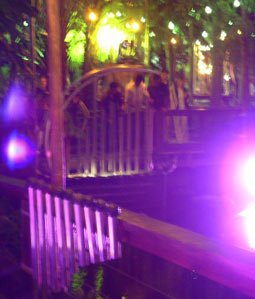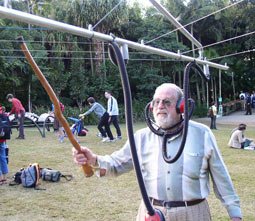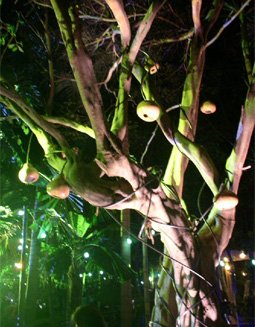an interactive sound installation for Qld Biennial Festival of Music 2003
Devised by Linsey Pollak
Constructed
by – Linsey Pollak, Steve Langton, David Murphy, Steve Weis and Mik Moore.
In the magical forest, a musical fantasy emerges.
Throughout the ten days of the festival, all day and into the night, strange sounds and wacky and wonderful instruments ‘grow’ in the Rainforest Walk and Rainforest Lawn at South Bank. In this enchanted musical playground, Queensland families experience a free, hands-on sound installation created by Australia’s leading instrument makers, sculptors and lighting designers. It’s an interactive musical playground, and a chance for all Queenslanders to create their own music deep in the heart of the forest.
1. Bamboo Boing Pipes (made by Mik Moore)
Boing pipes are tuned percussive resonant tubes that use a floating cap made from a plastic hemisphere as the struck surface that excites the air column. First designed by Jon Madin, they sound a bit like a thongaphone, but because beaters are used rather than thongs, it is possible to play faster rhythmic patterns. This installation features five separate instruments each with the same pentatonic tuning.
2. Railing Bentas (made by Linsey Pollak)
The Benta is an African-Derived glissed idiochord zither from Eastern Jamaica. It is a single string instrument (monochord) made from a long length of bamboo and played by 2 people. One person plays the instrument percussively with small beaters while the other controls the pitch by sliding a gourd along the string (made from the bamboo fibres). These are very similar but use a metal string on a timber body and are just perfect for placing on a walkway railing.
3. Shochord Jam Boxes (made by Linsey Pollak)
This simple instrument can provide hours of fun. It allows people to jam together by each plucking a different length of elastic cord. You control the pitch by the amount you pull the cord, so that with a small amount of practice you can play melodies or basslines or just come up with some damn funky rhythms.
4. Mini Boings (made by Linsey Pollak)
These are like the bamboo boings already mentioned, but the tubes are smaller and made from aluminium.
5. “Vox Bambusa” (made by Linsey Pollak)
Sing into the bamboo tube and your voice is electronically manipulated. Your own voice determines the pitch of the note but the tonal quality of the sound that comes back to you through another bamboo tube is totally different.
6. Water Chimes (made by Steve Langton)
These water chimes are made from aluminium tubes which change pitch when moved up and down in the water depending on how deep they hang in the water.
7. Midi Marimba (made by Linsey Pollak)
This instrument is a digital tuned percussion instrument. It is setup like a xylophone or marimba with 12 notes but the sounds are produced by a digital sound module that responds to striking the individual pads on the railing.
8. Pole Harp (made by Linsey Pollak)
The Pole Harp is made from a Hoop pine pole with steel strings running along its length. It is a giant version of a traditional harp from Madagascar which is much smaller and made from bamboo.
9. “Lily Pads” (made by Linsey Pollak)
This is a digital sound installation where you can trigger the sounds by jumping on the Lilypads on the boardwalk. Contact microphones transform the vibrations into electrical impulses which are then transformed into digital information and then converted into sounds by a digital sound module.
10. Tree fern (made by Steve Weis)
This metal tree fern makes a variety of sounds when stroked and struck. Tjhe metal vibrates and the overall metal structure creates it’s own reverberation. The sounds are amplified by a small amplifier, but apart from the increase in volume all the sounds you hear are inherent in this beautiful metal instrument.
11. Marimba Deck – 8 marimbas (made by Linsey Pollak)
Marimbas are found thoughout the world in various forms, particularly throughout Africa and in Asia and South and Central America. Marimbas come in many different forms and with a huge variety of different tunings. The marimbas in this group were made to show just a few of these different tunings:
1. Wagogo tuning –
Tanzania. 2. Byzantine Greek Hidzaz. 3. Javanese Pelog. 4. Sundanese Slendro.
5. Gambian Xylophone. 6. Ghanaian Xylophone. 7. Ziraf-Kend – Medieval Arabic.
8. Western equal tempered diatonic.
12. Bass Marimba (made by Mik Moore)
This bass marimba has PVC resonators which each have a buzzing membrane. These membranes are made from plastic shopping bag. Traditionally in various African and central American traditions the membranes are made from materials such as spider egg shell and pig intestine.
13. “Trifficone” (made by Steve Weis)
The Trifficone is a lamellophone with steel tongues arranged as flowers that create sound when plucked. Each blossom provides an independent instrument enabling a number of people to play the Trifficone at once. It has been propagated in the same Sound nursery as the Treefern – “The Wonky Bar Kid Imaginarium”.
14. Woven Sub Vibes (made by Steve Langton)
Five giant hand woven plastic baskets act as low frequency resonators for tuned aluminium planks. When hit, these ultra low frequency vibraphone keys produce notes from 25 hertz up to 40 hertz….(have you heard of the brown note?)
15. “Tae Kwon Doof” (made by Steve Langton)
Inspired by the Korean martial art and Japanese Taiko drumming, this plastic and stainless steel giant gong set is hit, punched or kicked to play bass drum patterns. Bring your elbow and knee pads!
16. Airbell arches (made by Steve Langton)
Using one of the totally new instruments invented in the 20th century, this installation features inflated PET (polyethylene tetrapthalate) soft drink bottles, tuned and arranged in one area. When hit with chop sticks, these bottle bells produce a surprising, infinitely tunable clear tone.
17. Spoonaphone (made by Dave Murphy)
Wooden spoon shapes are clamped tight and tuned. When they are hit with mallets or hands their sound is amplified by the sympathetically tuned resonators held below them to produce a warm, breathy sound. This is a totally new instrument, and the 2003 Sound Forest is it’s public debut. It’s like a big kalimba or thumb piano with resonators.
18. “Hills Harp” (made by Dave Murphy)
A standard family sized Hills Hoist is strung up with a variety of wires to produce a wide range of musical pitches when they are plucked or hit. You are invited to try on ear muffs that dangle from the musical clothes line that are “plumbed” in to the sound scape above, giving you personal direct access to the sounds.






